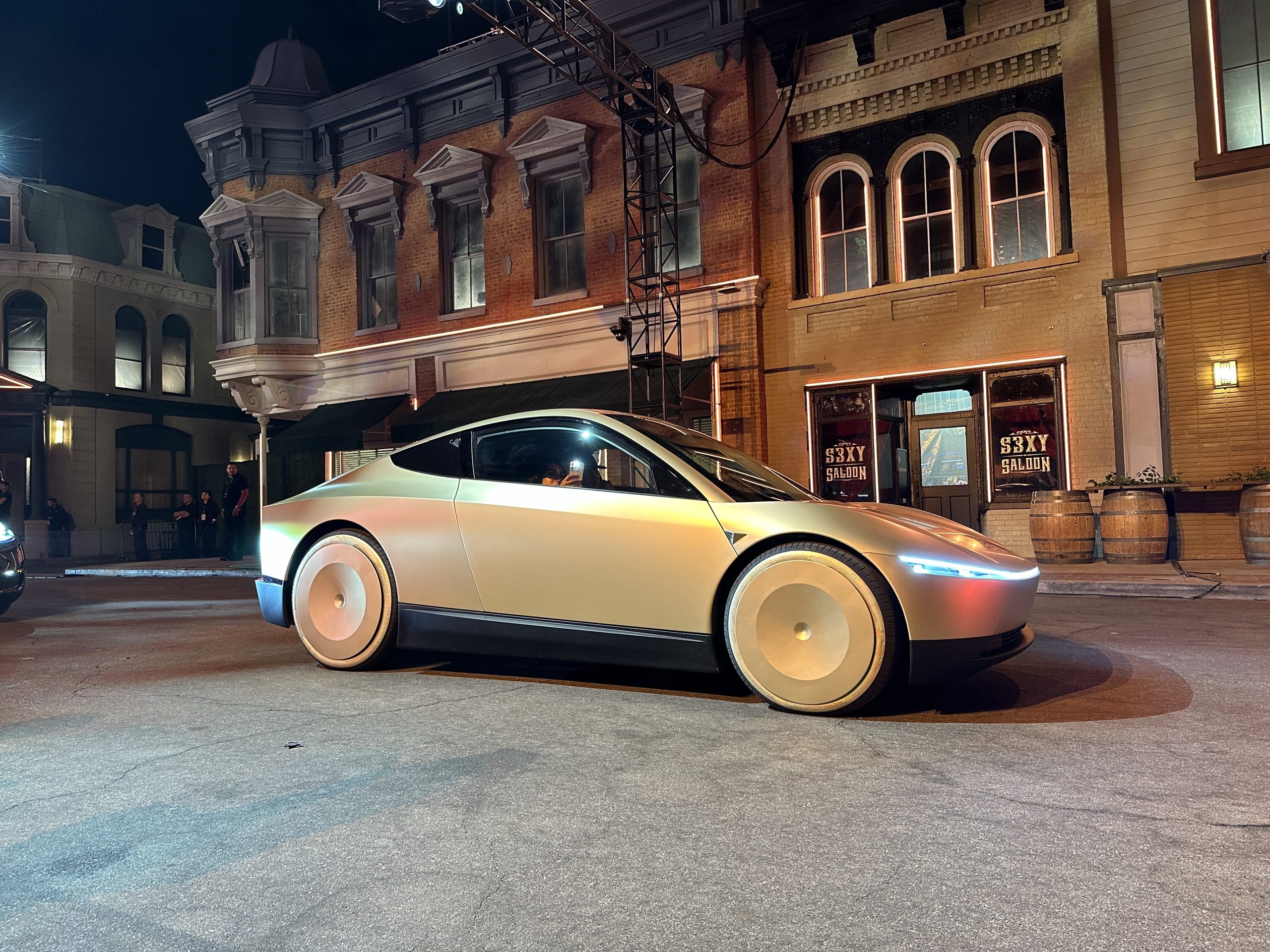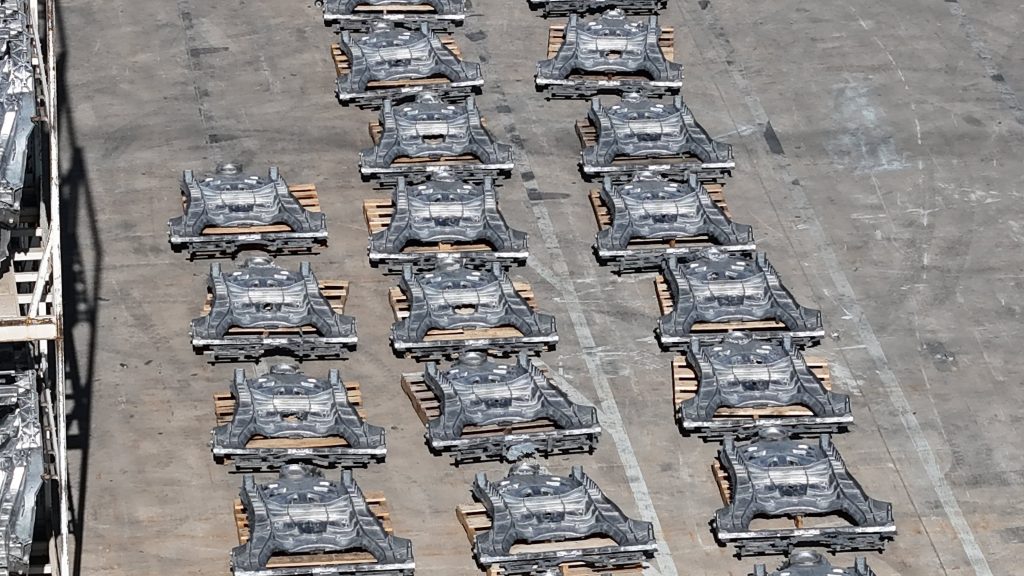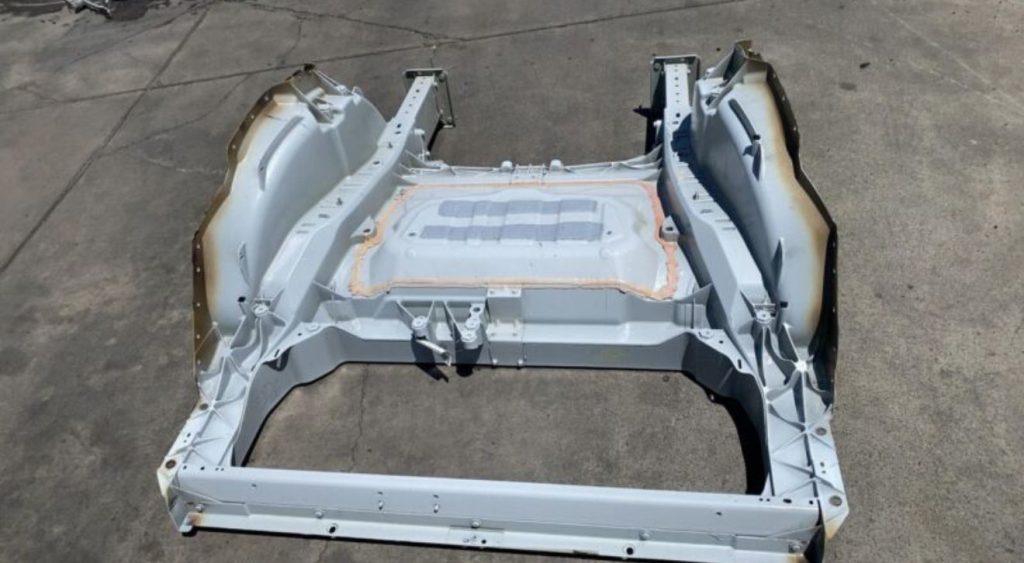News
Tesla building apparent Cybercab castings ahead of launch
Tesla has been producing what look like some Cybercab castings at Giga Texas, as spotted this week ahead of the vehicle’s upcoming launch.

Tesla’s Gigafactory in Texas is building what appear to be castings for the upcoming Cybercab, ahead of the vehicle’s launch and the highly anticipated debut of Unsupervised Full Self-Driving (FSD).
On Monday, Tesla Giga Texas site observer Joe Tegtmeyer shared photos on X of some unique castings out beside the factory. Notably, Tegtmeyer points out that the castings are quite different from those of the Model Y and Cybertruck, which are currently the only two vehicles being produced at the Austin, Texas plant—at least publicly.
Some viewers noted that the castings appear to have a similar shape to the Cybercab, along with being one single casting, compared to the two-piece Giga casts the factory produces for the Model Y and Cybertruck. The shape appears to be consistent with Tesla’s unboxed production process, which is expected to build single-piece castings and will be used for the upcoming Cybercab.
You can see Tegtmeyer’s photos of the castings below, in comparison with the Cybercab body and castings for the Model Y and Cybertruck.
Giga Texas castings April 21, 2025, compared to Cybercab

Credit: Joe Tegtmeyer | X

Credit: Joe Tegtmeyer | X
Giga Texas Model Y rear casting

Credit: Joe Tegtmeyer | X
Giga Texas Cybertruck castings

Credit: Joe Tegtmeyer | X
🎥: Our FULL first ride in the @Tesla Cybercab pic.twitter.com/6gR7OgKRCz
— TESLARATI (@Teslarati) October 11, 2024
READ MORE ON TESLA’S GIGA TEXAS: Tesla Cybercab no longer using chase vehicles in Giga Texas
In March, Tesla Vice President of Vehicle Engineering Lars Moravy confirmed in an interview with manufacturing expert Sandy Munro that Cybercab production would be starting prototype builds this summer, while the automaker is aiming to ramp for volume production in 2026.
While it isn’t summer yet, executives also confirmed in January that Cybercab production lines were already being prepared at Giga Texas, so it’s not unlikely that these castings are some of the upcoming vehicle’s first prototype builds.
The unboxed production process is also expected to revolutionize the automotive manufacturing industry, with CEO Elon Musk emphasizing how different the production line looks compared to its past vehicles during the Q1 2025 All-Hands meeting. Instead, Musk says the production line appears more like a high-speed consumer electronics line, and it’s expected to push Cybercab builds out in less than five seconds.
In a post on X earlier this month, Musk also reiterated that the Cybercab production line and the factory in general are essentially the products on their own, rather than just the cars themselves.
“The Tesla factory, especially our next gen Cybercab line, is the product,” Musk said. “That, autonomy and Optimus, are what matter.”
Tesla is also aiming to launch its first commercial robotaxi services around Austin, Texas this summer, along with launching its first iterations of Full Self-Driving (FSD) Unsupervised. The company is also holding its Q1 earnings call on Tuesday, during which executives are expected to address questions about the Cybercab and the upcoming commercial robotaxi service.
Tesla’s Giga Texas vehicles now drive themselves to outbound lot

News
Tesla starts showing how FSD will change lives in Europe
Local officials tested the system on narrow country roads and were impressed by FSD’s smooth, human-like driving, with some calling the service a game-changer for everyday life in areas that are far from urban centers.

Tesla has launched Europe’s first public shuttle service using Full Self-Driving (Supervised) in the rural Eifelkreis Bitburg-Prüm region of Germany, demonstrating how the technology can restore independence and mobility for people who struggle with limited transport options.
Local officials tested the system on narrow country roads and were impressed by FSD’s smooth, human-like driving, with some calling the service a game-changer for everyday life in areas that are far from urban centers.
Officials see real impact on rural residents
Arzfeld Mayor Johannes Kuhl and District Administrator Andreas Kruppert personally tested the Tesla shuttle service. This allowed them to see just how well FSD navigated winding lanes and rural roads confidently. Kruppert said, “Autonomous driving sounds like science fiction to many, but we simply see here that it works totally well in rural regions too.” Kuhl, for his part, also noted that FSD “feels like a very experienced driver.”
The pilot complements the area’s “Citizen Bus” program, which provides on-demand rides for elderly residents who can no longer drive themselves. Tesla Europe shared a video of a demonstration of the service, highlighting how FSD gives people their freedom back, even in places where public transport is not as prevalent.
What the Ministry for Economic Affairs and Transport says
Rhineland-Palatinate’s Minister Daniela Schmitt supported the project, praising the collaboration that made this “first of its kind in Europe” possible. As per the ministry, the rural rollout for the service shows FSD’s potential beyond major cities, and it delivers tangible benefits like grocery runs, doctor visits, and social connections for isolated residents.
“Reliable and flexible mobility is especially vital in rural areas. With the launch of a shuttle service using self-driving vehicles (FSD supervised) by Tesla in the Eifelkreis Bitburg-Prüm, an innovative pilot project is now getting underway that complements local community bus services. It is the first project of its kind in Europe.
“The result is a real gain for rural mobility: greater accessibility, more flexibility and tangible benefits for everyday life. A strong signal for innovation, cooperation and future-oriented mobility beyond urban centers,” the ministry wrote in a LinkedIn post.
News
Tesla China quietly posts Robotaxi-related job listing
Tesla China is currently seeking a Low Voltage Electrical Engineer to work on circuit board design for the company’s autonomous vehicles.

Tesla has posted a new job listing in Shanghai explicitly tied to its Robotaxi program, fueling speculation that the company is preparing to launch its dedicated autonomous ride-hailing service in China.
As noted in the listing, Tesla China is currently seeking a Low Voltage Electrical Engineer to work on circuit board design for the company’s autonomous vehicles.
Robotaxi-specific role
The listing, which was shared on social media platform X by industry watcher @tslaming, suggested that Tesla China is looking to fill the role urgently. The job listing itself specifically mentions that the person hired for the role will be working on the Low Voltage Hardware team, which would design the circuit boards that would serve as the nervous system of the Robotaxi.
Key tasks for the role, as indicated in the job listing, include collaboration with PCB layout, firmware, mechanical, program management, and validation teams, among other responsibilities. The role is based in Shanghai.
China Robotaxi launch
China represents a massive potential market for robotaxis, with its dense urban centers and supportive policies in select cities. Tesla has limited permission to roll out FSD in the country, though despite this, its vehicles have been hailed as among the best in the market when it comes to autonomous features. So far, at least, it appears that China supports Tesla’s FSD and Robotaxi rollout.
This was hinted at in November, when Tesla brought the Cybercab to the 8th China International Import Expo (CIIE) in Shanghai, marking the first time that the autonomous two-seater was brought to the Asia-Pacific region. The vehicle, despite not having a release date in China, received a significant amount of interest among the event’s attendees.
Elon Musk
Elon Musk and Tesla AI Director share insights after empty driver seat Robotaxi rides
The executives’ unoccupied tests hint at the rapid progress of Tesla’s unsupervised Robotaxi efforts.

Tesla CEO Elon Musk and AI Director Ashok Elluswamy celebrated Christmas Eve by sharing personal experiences with Robotaxi vehicles that had no safety monitor or occupant in the driver’s seat. Musk described the system’s “perfect driving” around Austin, while Elluswamy posted video from the back seat, calling it “an amazing experience.”
The executives’ unoccupied tests hint at the rapid progress of Tesla’s unsupervised Robotaxi efforts.
Elon and Ashok’s firsthand Robotaxi insights
Prior to Musk and the Tesla AI Director’s posts, sightings of unmanned Teslas navigating public roads were widely shared on social media. One such vehicle was spotted in Austin, Texas, which Elon Musk acknowleged by stating that “Testing is underway with no occupants in the car.”
Based on his Christmas Eve post, Musk seemed to have tested an unmanned Tesla himself. “A Tesla with no safety monitor in the car and me sitting in the passenger seat took me all around Austin on Sunday with perfect driving,” Musk wrote in his post.
Elluswamy responded with a 2-minute video showing himself in the rear of an unmanned Tesla. The video featured the vehicle’s empty front seats, as well as its smooth handling through real-world traffic. He captioned his video with the words, “It’s an amazing experience!”
Towards Unsupervised operations
During an xAI Hackathon earlier this month, Elon Musk mentioned that Tesla owed be removing Safety Monitors from its Robotaxis in Austin in just three weeks. “Unsupervised is pretty much solved at this point. So there will be Tesla Robotaxis operating in Austin with no one in them. Not even anyone in the passenger seat in about three weeks,” he said. Musk echoed similar estimates at the 2025 Annual Shareholder Meeting and the Q3 2025 earnings call.
Considering the insights that were posted Musk and Elluswamy, it does appear that Tesla is working hard towards operating its Robotaxis with no safety monitors. This is quite impressive considering that the service was launched just earlier this year.








